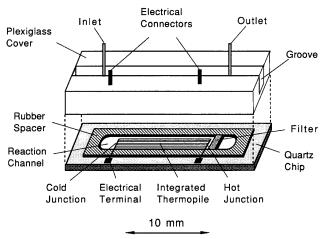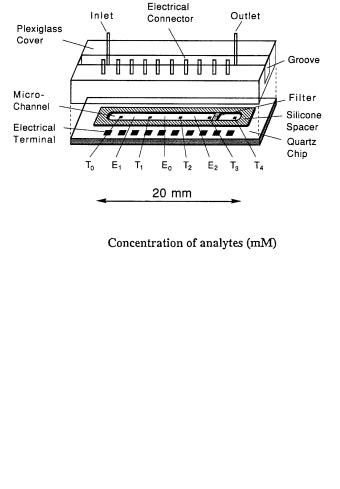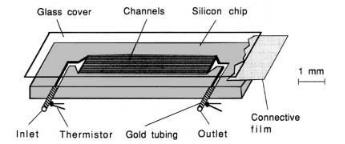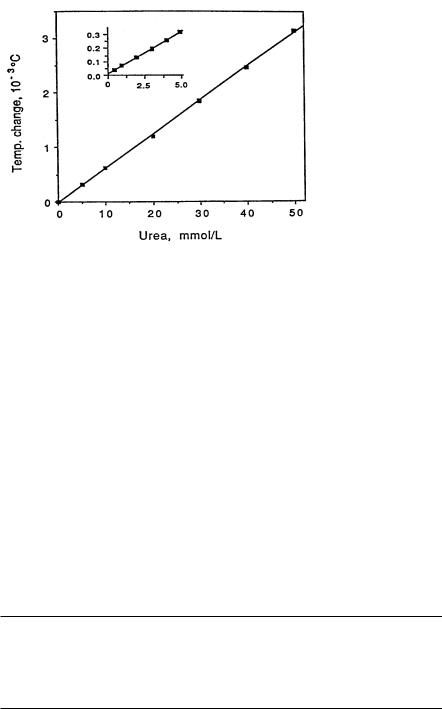
Principles of Enzyme Thermistor Systems
.pdfPrinciples of Enzyme Thermistor Systems: Applications to Biomedical and Other Measurements |
11 |
technique is surface micromachining, in which a sacrificial layer is selectively etched from below an etch-resistant thin film. Static and dynamic micromechanical structures have been fabricated by applying these processes in combination with low-pressure chemical vapour deposition on polysilicon. Such systems, i.e. that have the electronic properties of semiconductors, are comparable with thermistors, where there is a change in resistance as a function of temperature, or a thermopile based on the Seebeck effect or the p-n junction for the diode and transistor. In addition, integrated thermistors and thermopiles can be designed by doping boron into polysilicon, in order to achieve a temperature dependent change in resistance or to form a thermocouple in the presence of aluminium or gold.
An additional advantage of the integrated circuit technology is the ability to integrate the various components, such as the transducer, reactor, valve, pump etc., within the electronic system, forming refined flow-analysis systems on silicon wafers. Several approaches, such as electrostatic, electromagnetic, piezoelectric, thermopneumatic and thermoelectric can be employed for force transduction in the microvalves, these are also applicable to micropumps. Based on these approaches, two versions of micropumps have been developed. These are connected in parallel; the first pump (dual pump) is activated with periodic twophase voltage, while the second pump (the buffer pump) is driven by two piezoelectric actuators. Microsensors of two kinds are described below: a thermopile basedand a thermistor based microbiosensor.
2.3.1
Thermopile-Based Microbiosensor
The thermopile-based microbiosensor (Fig. 5) is fabricated on a quartz chip. Its functioning is based on the Seebeck effect: DV=n aab DT,where DV is the voltage output of one thermocouple; n stands for the number of thermocouples, DT is the temperature difference between the hot junction and the cold junction, and aab is the relative Seebeck coefficient, which is dependent on the composition of the material and on the working temperature. For small temperature ranges, the Seebeck coefficient aab can be considered to be constant. Thus, the voltage output of the thermocouple is proportional to the temperature difference, DT between the hot and the cold junctions. A thermopile was constructed by connecting a number of thermocouples in series. The thermopile has a much larger voltage output than a single thermocouple for the same temperature difference, since the output from the thermopile is equal to the sum of the outputs from each thermocouple. When the cold junction is maintained at a constant temperature and the hot junction is placed proximally to the exothermic enzyme reaction, the detection of the output voltage from the thermopile is directly related to the substrate concentration.
The integrated thermopile (1.6¥10 mm) was manufactured by the following method. A quartz chip (25.2 ¥14.8 ¥0.6 mm) was used as a substrate instead of a silicon wafer, in order to reduce the heat conductivity of the chip. A 0.5 mm thick layer of polysilicon was deposited using LPCVD (low-pressure chemical vapour deposition) onto the quartz substrate. The layer was boron-doped using

12 |
B. Xie et al. |
Fig. 5. Schematic diagram of the thermal microbiosensor based on an integrated thermopile fabricated on a quartz chip. Glucose oxidase immobilized on CPG beads was charged into the channel
ion implantation and then annealed in nitrogen at 950 °C for 30 min. Next, the layer was patterned by wet chemical etching, using negative photoresist as an etch mask. Metalization was accomplished through aluminum vapour deposition and an additional photolithographic patterning procedure. As a final step, the chip was annealed at 200 °C for 30 min. The surface of the chip was covered by a 30 mm thick layer of polyimide membrane to insulate the transducer electrically from flow liquid. The voltage output per degree of the integrated thermopile was about 2 mV/K at 22 °C.
On the chip,a silicone rubber membrane (0.32 mm thick was used to form the microchannel (17.5 ¥ 3.6 ¥ 0.32 mm) and to serve as a seal between the chip and the plexiglass cover. The inlet and outlet stainless steel tubing,as well as the electrical connectors, were mounted on the cover. The entire unit was held together with a screw-mounted delrin holder. This rather bulky construction was required in order to facilitate repeated access to the sensor chip. The CPG beads were charged into the microchannel by sucking them in from the outlet end. The beads were stopped at the hot junction using a filter made from a tiny piece of kleenex tissue. Two thirds of the channel from the hot junction were filled with the enzyme-containing beads. The remaining third was filled with similar beads without any enzyme, in order to reduce carryover of heat to the cold junction.
2.3.2
Thermistor-Based Microbiosensor
The thermistor-based device (Fig. 6), is composed of a transducer chip (21 ¥ 9 ¥ 0.57 mm), a spacer, and electrical and liquid flow connections. Five thermistors (T0–T4) with a temperature coefficient of 1.7% per degree (25 °C)

Principles of Enzyme Thermistor Systems: Applications to Biomedical and Other Measurements |
13 |
a
b
Fig. 6. a Schematic diagram of the sensor construction. T0 to T4 represent the film thermistors 0 to 4, respectively. E1 and E2 contain enzyme matrices 1 and 2. E0 represents the region containing the same carrier beads as the other regions but without immobilized enzymes. b Calibration curves for the simultaneous responses of glucose, urea and penicillin in a mixture. Oxygen was electrocatalytically generated in the buffer stream for the glucose oxidase reactions
were fabricated on the quartz chip along the microchannel with a spacing of 3.5 mm by doping in polysilicon and etching.
The thermistors were electrically insulated by depositing a layer of silicon oxide (low temperature oxide). The thermistors were then paired in two independent groups, T0 with T1 and T2 with T3 corresponding to the enzyme reactions in region E1 and E2 respectively. A silicone-rubber membrane (0.32 mm thick) formed the reactive channel (17.5 ¥ 0.8 ¥ 0.32 mm) and was also used
14 |
B. Xie et al. |
for sealing the device. In order to determine two substrates simultaneously, the enzyme regions E1 and E2 were charged with two different enzymes, which had been covalently immobilized on NHS-activated (N-hydroxy succinimide) agarose beads (13 mm in diameter, Pharmacia Biotech, Sweden). The E0 region was charged with similar beads without any enzymes, in order to damp the thermal carryover downstream at region E2 . In this scheme, T1/T3 and T0/T2 were employed as the measurementand the reference thermistor, respectively. The agarose beads were held in place, using a filter made of a tiny piece of kleenex tissue.A plexiglas cover, on which the inlet and outlet stainless-steel tubings and electrical connectors were mounted, was used to seal the holder. This design was rather bulky but was required in order to facilitate repeated access to the sensor chip. A typical example of multisensing of penicllin, glucose and urea is shown in Figure 6b.
2.4
Multisensing Devices
An important area in clinical diagnosis is the simultaneous determination of multiple analytes. This approach could be extended to personal healthcare, bioprocess control, and sequential enzyme reactions. In particular, it is essential in the realization of a personal healthcare system, as the information from multiple metabolites improves the reliability of the clinical diagnosis. Immense efforts have been made to develop biosensors for the determination of multiple analytes. Many of these employ multi-channel or split-flow systems, combined with electrochemical detection. A requisite of the multi-channel scheme lies in avoiding interference from other reactions. Nevertheless, uniformity of the flow rate in these multichannel systems (Fig. 7), especially in microchannels, is yet to be improved. Earlier attempts made use of a single flow channel in multianalyte determination. In applications involving electrochemical and optical detection, the system must be suitably regulated, in order to minimize the interference that can arise due to change in pH, ionic strength, electrocatalytic species, or chromophores produced during the reaction. In addition, the specificity of the electrode or the optical detector for the compound being measured is intrinsically dependent on the applied potential or the wavelength. The number of analytes, especially in whole blood, as well as the nature of the detection system, usually govern the detection conditions. Apart from methods in biosensing, multiple discrete samples [20] have also been measured by a centrifugal blood analyzer method based on a rotating sampling distributor. However, the inherent complexity of the latter technique prevents its routine application in delocalized clinical diagnosis.
In the recent past, multianalyte determination has found increased applications, i.e. specific and multiple reactions favor a system that allows the specific determination of each reaction, using the same principal measurement methods, detectors and conditions. In keeping with this idea, a flow injection thermometric method based on an enzyme reaction and an integrated sensor device was proposed for the determination of multiple analytes. In principle the technique relies on the specificity of enzyme catalysis and the universality of

Principles of Enzyme Thermistor Systems: Applications to Biomedical and Other Measurements |
15 |
Fig. 7. Schematic illustration of the thermal micro-biosensor fabricated onto a silicon chip
thermal detection. In this technique, a single microchannel column is serially partitioned into several discrete detection regions. Each of the regions, corresponding to the detection of one analyte, contains the corresponding enzyme and a pair of film thermistors. Each thermistor placed after the enzyme matrix, functions as the measurement transducer, whereas the other, placed before the enzyme, serves as the reference. As a substrate mixture flows through this reaction channel, multiple thermal signals generated from individual enzyme reactions are detected nearly simultaneously. One advantage of this design is that all determinations are performed under essentially identical conditions, such as flow rate, sample volume, pressure, and working temperature. Additionally, the effect of by-products of one enzyme reaction on the performance of other enzymes in the series has been found to be minimal.
The feasibility of this approach was demonstrated in dual analytes such as urea/penicillin and urea/glucose. In these investigations each detection region was charged with a different enzyme-agarose bead conjugate (13 mm in diameter). The rest of the channel was charged with a similar bead but without the immobilized enzyme. Complete filling of the channel is necessary to keep down the residence time of the samples within the reactor, as they pass through it. Consequently, determination of multiple analytes could be achieved nearly simultaneously. The error in measurement in such system was primarily caused by thermal carryover.This thermal effect,however,could be minimized by introducing a mini heat-sink between the reaction regions,using silicon or aluminum strips connected with the chip. According to this principle, it would be possible to determine even more analytes by this method, if additional thermal transducers are fabricated. In reactions where different reaction conditions of pH, ionic strength and cofactors are required for the various groups of enzymes/ analytes, multi-channels can be supplied. In the case of whole blood and crude samples, large bead size is preferred, in order to prevent clogging and to reduce the back pressure in the flow channel. In addition, direct immobilization of enzymes on a chip surface with extended coupling area would be a better choice if adequate enlargement of surface area could be achieved. It is also possible to employ an integrated thermopile as an alternative to the integrated thermistors in this system. In this case, each thermopile relates to one enzyme. Its one junction (hot junction) is placed downstream of the enzyme matrix to determine the
16 |
B. Xie et al. |
temperature change relative to the other junction (cold junction) maintained upstream at a constant temperature. The advantage of employing thermopiles for the determination of multiple analytes derives from its high rejection ratio of the common-mode thermal noise, and elimination of an additional element for the reference temperature, as is the case in thermistor based sensors.
The integrated system, including transducer and enzyme reactor, provides improved reliability and stability in multianalyte determinations, as compared with discrete thermal sensor systems. In addition, application of micromachining and IC technologies is of benefit for the manufacture of uniform, cheap thermal transducers with flexible shape, size, and resistance, as well as delicate microstructure on the chips. The good thermal insulation of the transducers from the flow stream eliminates interference from the reactants on the transducers, and the intrinsic stability of the transducers obviates the need for frequent recalibration of the sensors.
2.5
Hybrid Biosensors
As the name indicates, hybrid biosensors are an integration of two or more measurement principles for efficient detection of a specific analyte. In general, each type of biosensor has its merits and shortcomings. Electrochemical biosensors demonstrate good selectivity and can be regenerated electrochemically by using electron transfer mediators and/or cofactors. However, while analyzing sample mixtures, electrochemical measurements often suffer from interference by molecules other than the electroactive species being measured. The interference also depends on the applied potential. Although optical techniques have high sensitivity and selectivity, they may be affected by interfering chromophores and fluorophores, present or formed during the reactions. In the case of enzy- me-based thermal biosensors, nonspecific heat has to be avoided or balanced by differential measurement. On the other hand, since the thermal transducers are insulated from reactants and buffer, the direct interference with the thermal transducer by chemical compounds in the solution can be eliminated. This enables the determination of complex samples,such as blood using thermal biosensors.
A pioneering hybrid biosensor (Fig. 8a) was designed and demonstrated in our group [21]. This sensor scheme utilizes electrochemical regeneration of the electron mediator in combination with thermal detection, in order to extend the linear range for glucose and catechol measurements (Fig. 8b). Such electrochemical methods had been applied previously in fiber-optic biosensors where the indicator reagent was regenerated electrochemically. In principle, these approaches could be applied for the development of hybrid biosensors based on any oxidase or dehydrogenase. In addition, light-assisted regeneration of NADH may also be of interest in the creation of an optically assisted hybrid biosensor.

Principles of Enzyme Thermistor Systems: Applications to Biomedical and Other Measurements |
17 |
a
b
Fig. 8. a Schematic of the set-up for simultaneous electrochemical and thermometric determination of analytes (for a detailed explanation, see text). b Optimization of catechol detection using hybrid (electrochemical and thermometric sensing) for oxygen concentration and its effect on sensitivity of thermal detection [30]
3 Applications
3.1
General Applications
The metabolites determined using ET devices include alcohols, glucose, and lactate using alcohol oxidase [22], glucose oxidase [23] and lactate oxidase respectively. The detection limit for these compounds in pure solutions was in the submicromolar region. The normal procedure was to co-immobilize the oxidases with catalase in order to increase the total heat production, reduce the oxygen consumption, and eliminate the hydrogen peroxide. Cellobiose was measured by using b-glucosidase in combination with glucose oxidase and catalase. Determination of cholesterol and cholesterol esters was accomplished using cholesterol oxidase and cholesterol esterase, and of triglycerides by using lipase.
18 |
B. Xie et al. |
Typical sample matrices are blood, serum and fermentation broth. Oxalate in urine was also measured using oxalate oxidase [24]. Substrate recycling offered routes for highly sensitive measurements. An example was lactate (or pyruvate) determination with a co-immobilized LDH/LOD (lactate dehydrogenase/lactate oxidase) column that repeatedly oxidizes lactate to pyruvate and reduces pyruvate to lactate. Each cycle produces a considerable amount of heat [15]. A similar approach was employed for the determination of NAD+/NADH by co-enzy- me recycling by using lactate dehydrogenase plus glucose-6-phosphate dehydrogenase, and of ATP/ADP by coupling pyruvate kinase with hexokinase as the recycling enzymes. By operating at excessive glucose supply, a hexokinase column was used for indirect assay of ATP with micromolar sensitivity.A multiplicative effect could be attained by coupling the recycling systems of pyruvate kinase and of LDH/LOD [25].
Monitoring of specific proteins eluted from chromatographic columns was demonstrated using the ET as a direct online monitor for purification of proteins/enzymes. As an example, LDH was recovered from a solution by affinity binding of N6-(6-aminohexyl)-AMP-Sepharose gel, and the signal from the ET was used to regulate the addition of the AMP-Sepharose suspension to the LDH solution [26, 27].
3.2
Industrial and Process Monitoring
For bioprocess monitoring, the ET was employed in the assay of penicillin in fermentation broth, using b-lactamase or penicillin acylase [28]. Also, ethanol generated in alcohol fermentation by yeast was monitored using alcohol oxidase. Other metabolites that were monitored during fermentations include lactate, glycerol, acetaldehyde, sucrose and glutamine [29].
3.3
Clinical Applications
Metabolites in human blood are closely associated with the state of an individual’s health. Determination of metabolites is critical in clinical diagnosis, since they can serve as a criterion for judging the severity of the sickness. Of these metabolites, glucose, lactate and urea are most frequently determined. Special attention to determination of glucose in blood is due to the fact that diabetes is well known as a dangerous and widespread disease that results in a high glucose concentration in the blood. Some other effects of metabolites, such as urea and lactate, on shock, respiratory insufficiency, and heart and kidney diseases are understood to some extent.
3.3.1
In-Vitro Monitoring
For determination of the metabolites in human blood, samples were collected from veins into heparinized or EDTA containing tubes. For glucose analysis,NaF

Principles of Enzyme Thermistor Systems: Applications to Biomedical and Other Measurements |
19 |
Fig. 9. The linear range for urea detection using a miniaturized thermometric system
preservative was also included in the tubes. For lactate, this preservative does not stabilize the concentration and may inhibit enzyme activity [21, 30]. Urea (Fig. 9) was relatively stable for several hours after withdrawal. Using the thermal biosensors, the blood samples were directly analyzed without any additional treatment. The sampling rate in this case was from 12 to 90 assays per hour. Meanwhile, the same samples were determined with the reference methods. In the UV reference method, it is necessary to deproteinize the blood in order to stop the metabolism of several unstable analytes, since this method takes much longer than the biosensor method. This was achieved by adding perchloric acid to the blood at the start of the thermometric determination,in order to reduce the measurement error due to the concentration change in the sample. Higher concentrations of blood metabolites for comparison were achieved by adding small volumes of high concentration standards into the native blood samples. The results of the determination of glucose, urea and lactate [31] in whole blood are summarized in Table 2.
Table 2. Determination of glucose, urea, and lactate in undiluted blood using miniaturized thermal sensors
Metabolite |
Linear range |
CV (%) |
Sample |
Correlation |
Reference |
|
(mM) |
|
volume (ml) |
coefficient |
method |
|
|
|
|
|
|
Glucose |
0.5–20 |
3.7a |
1 |
0.980c |
Reflolux-S |
Urea |
0.2–50 |
4.1b |
1 |
0.989d |
UV |
Lactate |
0.2–14 |
|
1 |
0.984d |
UV |
a For 100 samples, b For 50 samples, c For 37 samples, d For 30 samples.
20 |
B. Xie et al. |
The results indicate that the linear ranges of glucose and lactate (oxidase reactions) in whole blood correspond well with those of the same metabolites in buffers. The sensor methods and the reference methods were in good correlation for all analytes. The precision for the standards in buffers was always better (about 2 – 3%) than that of the blood samples. This was ascribed in part to the instability of the metabolite concentrations in blood, particularly that of lactate. In addition, the blood viscosity and the nonspecific heat in the reaction can also affect the final results.
The primary features of this method are its general principle, a uniform measurement system, the use of untreated blood samples, minute sample volumes, no fouling of the transducers, no electrochemical or optical interference, simple procedures, rapid response, and low cost. According to the working principle, other metabolites associated with enzyme reactions – in addition to glucose, urea and lactate – can be analyzed in a similar way. Unlike electrochemical and optical detection, where the potential or wavelength must be adapted to a specific analyte, no modification is needed for this measurement system other than replacement of the enzyme matrix or column. Isolation of the thermal transducers from the reactants avoids fouling from blood samples, and facilitates the stability and long-term operation of the sensors. The requirement of small amounts of enzyme and sample, as well as the capability of more than 100 blood assays per enzyme column, made the determination cheap and convenient, for instance by using capillary blood taken from the finger. Recently cholesterol determination was revisited, and a procedure was developed that allows estimation of free and esterified LDL/HDL cholesterol [32].
A miniaturized thermal biosensor was evaluated [33] as part of a flow-injec- tion analysis system for the determination of glucose in whole blood. Glucose was determined by measuring the heat evolved when samples containing glucose passed through a small column containing immobilized glucose oxidase and catalase. Samples of whole blood (1 ml) were measured directly, without any pretreatment. The correlation between the response of the thermal biosensor and other devices, i.e. the portable Reflolux S meter (Boehringer Mannheim, Fig. 10a), the colorimetric Granutest 100 glucose test kit (Merck Diagnostica) and the Ektachem (Kodak) instrument (Fig. 10b), was evaluated. The influence of the hematocrit value and of possible interference was reported. The correlation measurements showed that the thermal biosensor generally give lower values than the reference methods when aqueous buffer standards were made for calibration of the ET. Mean negative biases range from 0.53 to 1.16 mM. Differences in sample treatment clearly complicated the comparisons and the proper choice of reference method. There was no influence from substances such as ascorbic acid (0.11 mM), uric acid (0.48 mM), urea (4.3 mM) and acetaminophen (0.17 mM), on the response to 5 mM glucose. The hematocrit value did not influence the glucose determination, for hematocrit values between 13 and 53%.
